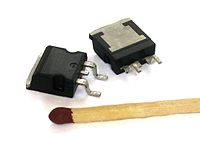
Photo from wikipedia
Based on a kinetic model involving oxidant diffusion and an oxidation-reduction reaction, a 3-parameter equation is derived relating the change in the concentration of thermally induced carrier donors in common… Click to show full abstract
Based on a kinetic model involving oxidant diffusion and an oxidation-reduction reaction, a 3-parameter equation is derived relating the change in the concentration of thermally induced carrier donors in common metal-oxide semiconductors (such as indium-gallium-zinc oxide and indium-tin-zinc oxide) to heat-treatment time. The change in the concentration of such donors is characterized by measuring the shift in the turn-on voltage of a thin-film transistor subjected to heat treatments in different atmospheres for different durations. The model parameters are extracted using optimal curve-fitting techniques, leading to the determination of relevant activation energies from the temperature dependence of the extracted parameters. The proposed model is found to be applicable to metal-oxide semiconductors of different compositions. It is discovered that the generation of donors in a non-oxidizing atmosphere is largely suppressed at a temperature below 250 °C, but the effective annihilation of the donors spans over a wider temperature range in an oxidizing atmosphere.
Journal Title: Small
Year Published: 2022
Link to full text (if available)
Share on Social Media: Sign Up to like & get
recommendations!